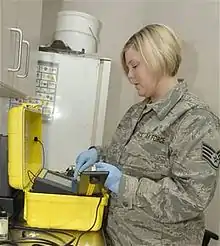Bioenvironmental Engineering
Bioenvironmental Engineering is a process of using engineering principles to reduce and solve environmental health risks and dangers caused by human activity[1][2] It may comprise four general areas of work : radiation, industrial hygiene, environmental protection and emergency response.
| Bioenvironmental Engineering | |
|---|---|
| Active | 1947 - Present |
| Country | United States |
| Branch | United States Air Force |
| Motto(s) | "Garrison equals deployed" |
| Colors | Yellow and Black |
| Mascot(s) | BEE |
During the 1970s the US Air Force saw a need to implement the measures to protect the health of personnel. It took elements of Military Public Health and spun off a separate arm called Bioenvironmental Engineering. From that point Bioenvironmental Engineering has taken the lead in protecting the health of Air Force workers.
The original group of Bioenvironmental Engineers (BEEs) came to the Air Force from the U.S. Army in 1947 when the Air Force was formed. They were an outgrowth of the U.S. Army Sanitary Corps. Until 1964, Air Force BEEs were called Sanitary and Industrial Hygiene Engineers. They were Medical Service Corps (MSC) officers until the Biomedical Sciences Corps (BSC) was created in 1965.
Between 1960 and 1970, the BEE field grew from around 100 to 150. However, beginning in 1970, with the formation of the Occupational Safety and Health Administration (OSHA), the U.S. Environmental Protection Agency (EPA), and the Nuclear Regulatory Commission, the career field experienced an exponential growth in Federal regulations. These laws require BEEs to monitor Air Force operations for their effects on personnel and the environment. Several major catastrophes and other events focused keen Congressional interest on environment, safety and occupational health (ESOH), leading to new, mandatory compliance programs. Love Canal, Bhopal, atmospheric ozone depletion, and other incidents spawned new laws governing the Installation Restoration Program; Hazard Communication; community-right-to-know; Process Safety Management; and hazardous material inventory, control and reduction. These have continually driven additional, corresponding requirements for BEEs.
In the early 1980s, a major shift in functions occurred. The clinical and sanitary aspects of the BEE program, (communicable disease, sanitary surveys, vector control, and occupational medicine) were turned over to the newly forming environmental health officers. This enabled the BEE force to concentrate its efforts on the industrial work place and the environment.
The importance of ensuring Air Force compliance with ESOH requirements is higher than ever. Public awareness/concern/disclosure, the recognition of risk analysis/communication/management, loss of sovereign immunity of federal agencies, and the personal liability of commanders for environmental infractions are all impacting BEE surveillance programs. Increased environmental pollution prevention and occupational health preventive medicine programs are shifting the emphasis to avoiding problems before they occur.

Bioenvironmental Engineering personnel are taught at the United States Air Force School of Aerospace Medicine at Wright-Patterson Air Force Base in Dayton, Ohio. Bioenvironmental Engineering blends engineering and preventive medicine. Their role is to identify and evaluate environments that could harm Air Force members, employees, and families. The data from these evaluations help design measures that prevent illness and injury.
Areas of specialty
Areas of specialty include:
- Airborne dusts, fumes, fists, fogs, vapors, or gases
- Biological hazards
- Biomechanical stresses
- Chemical hazards
- Chemical protection clothing, devices or equipment
- Cold stress
- Confined space hazards
- Drinking water
- Employee exposures
- Environmental sampling
- Environmental Health Repetitive Motion Stresses
- Ergonomic Stress
- Hazardous materials
- Health hazards
- Heat stress
- Indoor Air Quality
- Industrial hygiene
- Personal hygiene
- Ionizing Radiation
- Laser Safety
- Lead hazards
- Musculoskeletal disorders
- Noise hazards
- Nuclear Regulatory Commission (NRC) Permits
- Occupational Safety and Health Administration (OSHA) Health Standards
- Radioactive materials
- Radiofrequency radiation emissions
- Respiratory Protection Program
- Skin hazards
- Thermal stress
- Ventilation Requirements for Health
- Vibration hazards
See also
- Biomedical Sciences Corps
- Exposure action value
- Air Force Medical Service
- Air Force Knowledge Now
- Air Force Specialty Code
References
- "U.S. Air Force - Career Detail - Bioenvironmental Engineering". www.airforce.com. Retrieved 2018-01-19.
- "Bioenvironmental Engineering: Undergraduate Program Student Handbook" (PDF). Rutgers University. Rutgers University. September 2017. Retrieved 19 January 2018.
External links
- Air Force Careers (Bioenvironmental Engineering Apprentice)